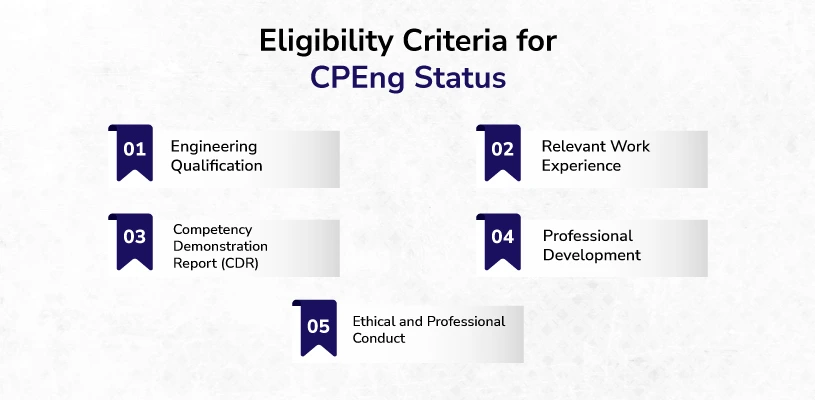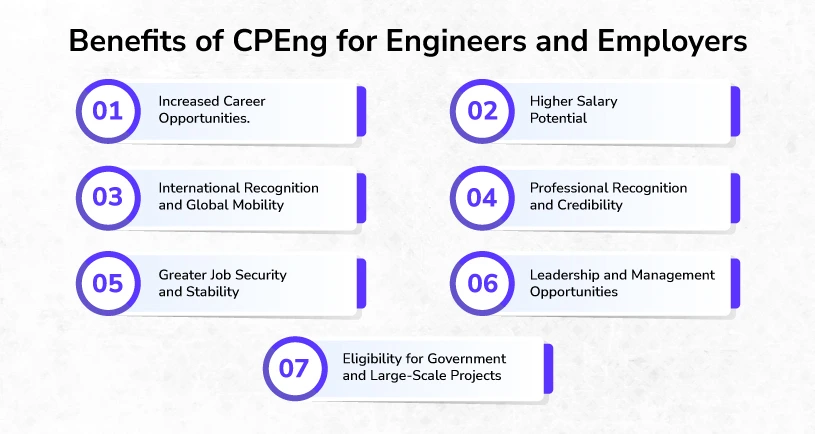
Australia acknowledges engineering professionals as essential for developing its infrastructure through technological advances while fueling industrial expansion. Engineering professionals in Australia recognise the Chartered Professional Engineer (CPEng) status as their most distinguished certification.
The CPEng designation represents complete professional competence along with strict ethical practices and dedicated professional growth commitment.
We will study CPEng status, including its meaning, importance, qualifications, application steps, as well as career advantages and career advancement potential for engineers who attain this remarkable certification.
🔑 Key Highlights
- Chartered Professional Engineer (CPEng) Status: Australia recognises CPEng as its top engineering accreditation, which demonstrates both professional excellence and ethical practice at an advanced level.
- Eligibility for Chartered Professional Engineer: The pathway to becoming a CPEng involves holding a qualified degree accredited by the institution alongside 5 years of professional experience and competency demonstrations, coupled with continuous professional development requirements.
- Benefits of CPEng Certification: Professional engineers holding the Chartered Professional Engineer designation earn better career development, together with elevated income and global work possibilities, as well as the potential to bid for official projects.
- CPEng Application Process: Candidates pursuing CPEng certification must first join Engineers Australia and complete a competency-based application while taking part in an interview process and upholding their CPD requirements.
Table of Contents
Chartered Professional Engineers (CPEng) Australia
Engineers Australia (EA) has established strict competency evaluation criteria for engineering professionals who want to achieve their CPEng designation. This status operates according to the organisation’s professional standards for engineers across Australia. CPEng status represents professional excellence that obtains recognition both inside Australia and abroad.
The process of becoming Chartered indicates that engineers can execute sophisticated engineering work while honouring professional criteria and actively developing their abilities through ongoing learning.
The Role of Engineers Australia in CPEng Certification
Engineers Australia (EA) controls both the professional assessment procedures and the CPEng status authorisation process. Before Engineers Australia awards a Chartered status, the organisation verifies that engineers demonstrate competence according to national and international professional standards. EA performs a thorough assessment system that follows International Engineering Alliance (IEA) agreements to create CPEng as an internationally recognised certification.
Why is CPEng status important? 💡
- The acquisition of CPEng status benefits engineers in Australia through multiple waypoints.
- The professional recognition from CPEng status demonstrates your expert engineering competence to customer employers and fellow professionals throughout the industry.
- The requirement for Chartered Engineer certification from most employers creates better promotion opportunities and opens doors to lead positions in the workplace.
- The CPEng designation holds international prestige, making it simpler to pursue international work through Washington Accord agreements.
- The process of gaining chartered status leads engineers to higher income potential and more favourable career opportunities.
- Engineers must complete their CPEng status to sign off on projects and approve designs in specific engineering roles, especially within infrastructure, construction, and consulting functions.
- The main requirement for Chartered engineers includes strict adherence to professional ethical guidelines, which generates trust and builds credibility throughout the industry.
Eligibility Criteria for CPEng Status

Those who want to achieve CPEng status in Australia need to fulfil particular eligibility criteria.
1. Engineering Qualification
The requirement for CPEng status demands professional engineering candidates to graduate from an educational institution whose programs are accredited by Engineers Australia, with their primary qualification being a standard four-year undergraduate programme leading to a Bachelor of Engineering degree or its international equivalent.
2. Relevant Work Experience
Clear eligibility for the CPEng status demands at least five years of professional engineering experience as evidence of competence in areas such as problem-solving, project management, leadership, and ethical responsibilities.
3. Competency Demonstration Report (CDR)
To apply for professional engineer status, candidates must send evidence of their competencies. This can be done through:
Competency Demonstration Report (CDR) functions as the evaluation method for international engineering graduates who do not have their degrees certified by Engineers Australia.
4. Professional Development
Engineers need to demonstrate their dedication to lifelong learning as well as skill improvement activities. Engineers need to prove their active participation in continuous professional development (CPD) activities through documentation.
5. Ethical and Professional Conduct
Engineers Australia Code of Ethics requires candidates to practice engineering in compliance with professional ethical and high-quality standards.
How to Apply for CPEng Status in Australia 🤷♀️

To receive CPEng status, candidates need to advance through several mandatory stages.
Step 1: Engineers Australia memberships
Before applying for CPEng status, one must become a Member (MIEAust) of Engineers Australia. Access to resources coupled with guidance is available through membership for achieving Chartered status.
Step 2: Prepare Competency Evidence
Candidates need to present documents showing their abilities in 16 elements throughout four main sections.
- Personal Commitment: Ethics, responsibility, and lifelong learning.
- Obligation to the Community: Safety, sustainability, and environmental impact.
- Technical Proficiency: Engineering knowledge, problem-solving, and innovation.
- Professional Skills: Leadership, teamwork, communication, and management.
Engineers Australia requires evidence that incorporates workplace achievements as well as reports and case studies along with employer references.
Step 3: Submit an Application
Engineering applicants need to utilise the myPortal system to submit their evidence-based competency documents on the Engineers Australia website.
Step 4: Professional Interview
The candidate’s knowledge and experience, along with ethical understanding, are assessed through interviews conducted by a panel of Chartered engineers who review the application.
Step 5: Assessment Outcome
The recipient receives the CPEng status when the application proves successful. Engineers Australia requires further information from applicants when more clarity is required.
Benefits of CPEng for Engineers 😮
1. Increased Career Opportunities
Engineers who obtain CPEng certification improve their employment opportunities in the market. Employers usually select Chartered Engineers because of their recognised high-level expertise combined with their professional behaviour.
Why is this important?
Engineers with CPEng credentials have better job accessibility in governmental entities and private sector establishments, along with consulting organisations.
Employing a CPEng certification leads employees to easily secure management roles plus leadership positions.
The CPEng designation allows practitioners to enter international job markets because Engineers Australia has authorised its recognition in various countries.
Building contractors strongly favour civil engineers holding CPEng status to work on critical infrastructure projects since Engineers Australia verifies their qualifications.
2. Higher Salary Potential
Registered Engineers who attain their Chartered status earn better income levels than their unlicensed counterparts. Engineers who earn CPEng certification demonstrate superior abilities and expertise as well as leadership competencies, which authorise their employment at higher compensation levels.
How does CPEng affect salary?
The certification enables Chartered Engineers to extract better salary packages and enhanced benefit packages.
Employers typically give Chartered Engineers additional compensation through both bonus rewards and advancement opportunities.
Engineering contractors who possess CPEng certification enjoy increased opportunities to set higher consulting fee rates for their clients.
Research shows that Australian Chartered Engineers receive payments 10–25% higher than their non-certification engineering counterparts within similar positions.
3. International Recognition and Global Mobility
Engineers who hold CPEng certification can work internationally because this designation has approval from Engineers Australia to access countries with Mutual Recognition Agreements (MRAs).
Countries that recognise CPEng include:
The United Kingdom recognises the CEng designation of Chartered Engineer in the same way as CEng because it is equivalent to CEng status.
🌍 United States (PE, Professional Engineer)
🌍 Canada (P.Eng., Professional Engineer)
🌍 New Zealand, Hong Kong, Singapore, and others
Why is this beneficial?
The ability to work in different countries comes naturally to engineers who share the CPEng certification.
Working professionals can easily acquire visas and work permits to fill engineering positions throughout the world.
The likelihood of securing employment with international engineering enterprises is enhanced.
An Australian mechanical engineer holding CPEng certification obtains automatic eligibility for job opportunities in Canada and the UK without completing extra competency tests.
4. Professional Recognition and Credibility
The CPEng status improves engineering professionals’ trustworthiness in their industry field. People who hold a CPEng qualification demonstrate their ability to provide both shareholders and colleagues through three key features.
✔ Meet high ethical and technical standards.
Engineers with CPEng status demonstrate the ability to lead engineering project management tasks independently.
✔ Have a proven track record of engineering excellence.
How does this help?
Engineers who obtain professional recognition through the CPEng status develop more authority within their profession.
The profession demands from CPEng holders the responsibility to handle sophisticated tasks alongside making essential choices.
Through mentoring activities along with professional contributions, engineers who hold the Chartered status help guide beginning engineers towards growth.
5. Greater Job Security and Stability
The CPEng status creates enduring occupational security. Multiple industries, such as construction, along with mining, energy, and transportation, choose to keep Chartered Engineers because these experts provide superior expertise and demonstrate professional competence.
Benefits of CPEng for job security
🔹 Preferred for long-term and permanent roles.
CPEng status helps engineers retain their employment positions in times of organisational reorganisation or economic recessions.
🔹 Increased chances of career progression in senior management roles
The competitive job market favours Chartered Engineers because their verified competencies protect them against layoffs compared to non-Chartered Engineers.
6. Leadership and Management Opportunities
A professional CPEng designation demonstrates an engineer’s qualifications to supervise both teams and engineering projects. Multiple senior roles in engineering firms, government agencies and multinational companies mandate employees to hold CPEng status.
What leads Chartered Engineers to obtain professional advancement at a superior rate?
- The strong leadership abilities, together with effective decision-making skills, serve as marks of distinction for them.
- Chartered engineers demonstrate leadership abilities through their mentorship roles to junior engineers and their status as professional models.
- Employers grant them the responsibility to guide massive budgeted projects.
- A Chartered Structural Engineer has higher probabilities to advance their career to either Engineering Director or Head of Projects.
7. Eligibility for Government and Large-Scale Projects
Various government and infrastructure projects demand Chartered Engineers for positions of importance.
Opportunities for Chartered Engineers include:
🏗 Working on national highways, railways, and energy projects.
🏗 Applying for public sector roles in regulatory bodies and research institutions.
The professional leadership of projects takes place across defence fields as well as telecommunications and renewable energy sectors.
A chartered engineer needs approval from the Australian Government for overseeing public infrastructure designs on bridges and tunnels.
Conclusion
A Chartered Professional Engineer (CPEng) designation stands as a vital accomplishment for Australian engineers during their professional development. The CPEng designation both verifies engineers’ competence and improves their job prospects and provides access to international professional prospects. The process contains strict requirements to identify engineers who exhibit both exceptional competence and ethical behaviour, which act as a symbol of professional achievement.
Engineers who want career advancement should view the CPEng certification as an investment of value. Engineers who want to advance their careers through leadership positions or earn higher income and gain worldwide recognition must earn Chartered status to achieve professional credibility.
Engineers who want to obtain Chartered status should begin their journey by joining Engineers Australia while preparing their competency claims since your path to professional excellence starts today.
FAQs
1. Is CPEng worth it?
CPEng is worth it for leadership roles, international work and regulated sector employment. You only need it if your professional career leads you to those roles.
2. How to become a chartered professional engineer in Australia?
- Meet Requirements
- Join Engineers Australia.
- Prove Competencies
- Pass Assessment
- Maintain CPD
3. What is the difference between CPEng and NER?
CPEng recognises high-level competency and leadership in engineering, whereas NER is a public register of qualified engineers meeting industry standards.
4. Do I need CPEng?
Yes, if you want senior roles, international opportunities, or work in regulated industries.
5. How many Chartered engineers are there in Australia?
As of the 2022-2023 period, Engineers Australia reported 34,084 Chartered members, reflecting an 11.8% increase from the previous year.





